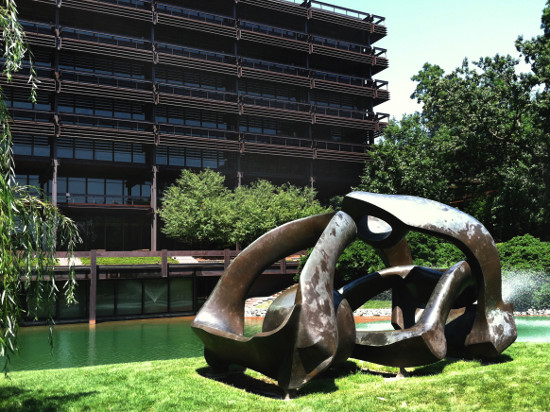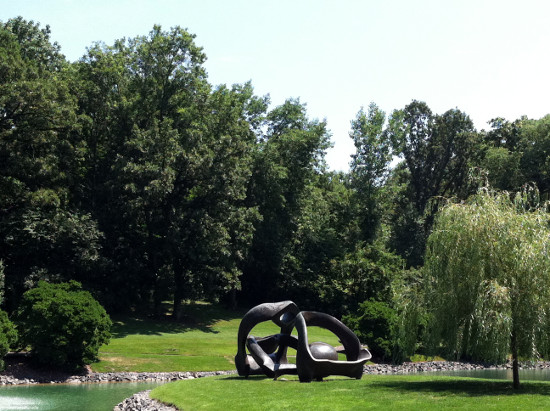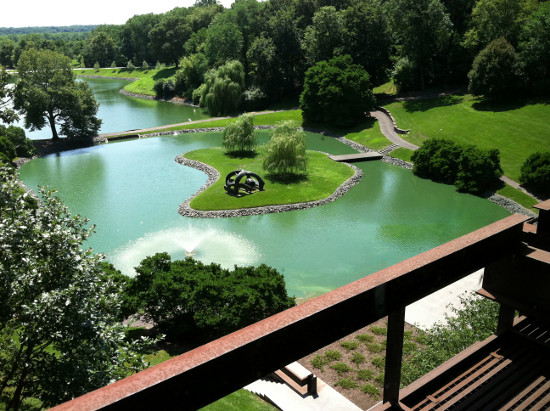
Hill Arches is a bronze sculpture created in 1974 by one of the most prominent sculptors of the 20th Century, Henry Moore (1898-1986). Moore's monumental works are often based on human forms, but as its title suggests, this piece is meant to be seen in a relationship with its environment.
It is located on a small island in the reflecting pond directly in front of the Deere & Company world-headquarters building in Moline, off John Deere Road a little more than three miles east of Interstate 74.
Viewed from the island, the sculpture is massive. Weighing more than 8,800 pounds, it is 18 feet in length and 12 feet high. But when viewed from a distance, its open spaces give it an unfolding, rising quality. Though large, it appears to float just above the lawn, its base hidden by the grass. This is a fitting paradox for a sculpture that works both with the modern architectural style of the world headquarters and with its surrounding landscape.

The building, flush against the reflecting pond, was designed by architect Eero Saarinen (1910-1961), who also designed the Gateway Arch in St. Louis. Since opening in 1964, the headquarters building has been regarded as one of the most significant modern buildings - especially in its pioneering use of unpainted high-tensile steel that formed its own protective coating as it weathered.
The appearance of the weathered exterior was intended to relate to the coloration of the trunks of surrounding oak trees. The building's design was also meant to express the company's identity. In a letter to the architect in 1957, Deere President William Hewitt wrote: "In thinking of our traditions and our future, and in thinking of the people who will work in or visit our new headquarters, I believe it should be thoroughly modern in concept but at the same time be down-to-earth and rugged."
Seen against the building, the sculpture's hard metal surface and cut edges are emphasized. The powerful repetition of the building's steel beams also seems to draw out the four interrelated shapes of the sculpture that imply a mechanical assembly of machined parts.
Yet the sculpture fits equally well with its surrounding environment. The organic qualities of its shapes reflect the curvilinear shape of the island as well as the wooded land that rises around the pond.

The collective relationships among the environment, the building, and the sculpture were developed by landscape architect Hideo Sasaki (1919-2000), who was instrumental in modernizing the concepts of landscape architecture. The department chair of landscape architecture in the Harvard Graduate School of Design and founder of Sasaki Associates, he was a pioneer of collaboration among design disciplines and an advocate of environmental responsibility. The ponds, for example, were designed with Saarinen to serve as a reservoir for flash floods and as a heat-exchange vehicle for the air-conditioning system.
An exceptional integration of environment, architecture, and artwork, the Deere & Company world headquarters include a visitor center open to the public.
Bruce Walters is a professor of art at Western Illinois University.
This is part of an occasional series on the history of public art in the Quad Cities. If there's a piece of public art that you'd like to learn more about, e-mail the location and a brief description to BD-Walters@wiu.edu.










